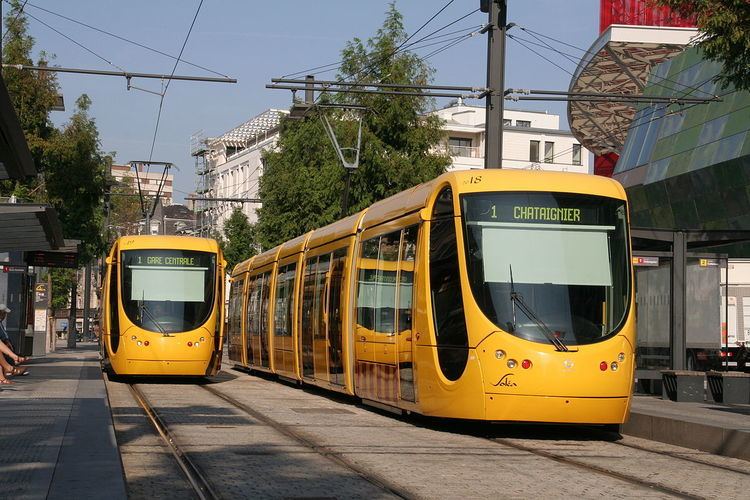 | ||
The Citadis is a family of low-floor trams (streetcars) and light rail vehicles built by Alstom. More than 1140 Citadis trams are in use in over 28 cities, including: Bordeaux, Grenoble, Lyon, Montpellier, Rouen, Orléans, the Paris area, Nottingham, Algiers, Oran, Constantine, Barcelona, Dubai, Dublin, Istanbul, Gdańsk, Katowice, Adelaide, Melbourne, Jerusalem, Rabat, Casablanca, Tunis, Rotterdam and Rio de Janeiro. An evolution of Alstom's earlier TFS vehicle, most Citadis trams are made in Alstom's factories in La Rochelle, Reichshoffen and Valenciennes, France, and in Barcelona, Spain, and Annaba, Algeria. Also, Gaziantep bought second-hand TFS's from Rouen.
Contents
Competitors to the Citadis include Bombardier Transportation's Flexity family, Siemens's Combino, Avenio, S70/Avanto trams and LRVs, CAF's Urbos, Škoda ForCity and other Škoda tramcars, AnsaldoBreda Sirio, TMK 2200 from Crotram and Kinki Sharyo LRVs.
Citadis types
The Citadis family includes both partial and fully low-floor trams and LRVs, in versions with three (20x), five (30x), seven (40x), and nine (50x) sections. It comprises the following standard variants:
Articulated models
Specialty models
Tram-trains
The “Regio-Citadis” variant is designed for tram-train operation, with trams running on mainline railway tracks; it is used on RegioTram Kassel and RandstadRail in and around The Hague. This train type can be built as a dual-voltage or electro-diesel vehicle with various configurations (diesel / 600 V DC, 600 V DC / 15 kV 16 2⁄3 Hz or 600 V DC / Bioenergy / diesel).
The Regio-Citadis model has now been superseded by "Citadis-Dualis", redesigned to operate on the same lines as regional trains (on the TER (Transport express régional) network in France) at up to 100 km/h (62 mph), compared to 70 km/h (43 mph) for the standard Citadis tram), and for stop spacings ranging from 0.5 to 5 km (0.31 to 3.11 mi). A total of 31 sets have been ordered (plus 169 on option) by the SNCF at an average cost of €3.2 million per train set (about $4.94 million or £2.5 million).
Power supply
Like most trams, Citadis vehicles are usually powered by overhead electric wires collected by a pantograph, but the trams in several places do not use pantograph current collection entirely.
The most popular solution is Alstom's proprietary ground-level power supply (APS, first used in Bordeaux and subsequently in Angers, Reims, Orleans, Tours, Dubai, Rio de Janeiro, and in the future, Sydney), consisting of a third rail which is only powered while it is completely covered by a tram so that there is no risk of a person or animal coming into contact with a live rail. On the networks in France and in Sydney, the trams switch to conventional overhead wires in outer areas, but the Dubai vehicles are the first to employ APS for its entire passenger length (although they are still equipped with pantographs for use in the maintenance depot).
Another option is to use on-board batteries to store electrical power, allowing brief periods of catenary-free operation without the need to install special infrastructure. The Citadis trams in Nice operate off a set of nickel metallic hydride batteries in two large open spaces where overhead wires would be an eyesore.
